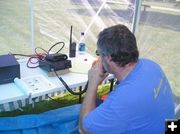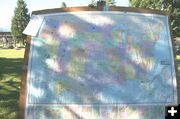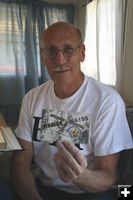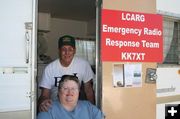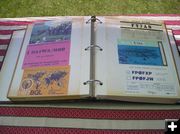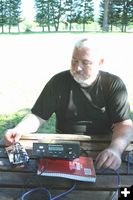Lincoln County Amateur Radio Group
by Maggie Craig
April 24, 2009
If you’ve ever had an interest in ham radio, upcoming events will provide the opportunity to investigate the hobby. Bill Cunnane, a ham radio operator with the Lincoln County Amateur Radio Group, will be at the Heritage Museum for opening day, May 30, and at Troy’s 4th of July celebration at Roosevelt Park. (His call sign is KK7XT, name Bill, operating SSB and CW on 10-80 meters HF. QSL via KK7XT w/SASE).
The Lincoln County Amateur Radio Group is a collection of people in the area who share a love of operating two-way radios and communicating with others around the world. The group holds an annual Field Day exercise in June, which was June 28-29 last summer, and will be June 27-28 this coming summer. As part of the Amateur Radio Relay League’s nationwide 24-hour exercise, it tests amateur (also called "ham") radio operators’ readiness to handle emergency situations without the use of commercial power. Generators and batteries are used instead, and antenna wire is slung high between trees with the aid of slingshots and fishing poles.
Last year, three such stations were set up for the Libby Field Day, with operators working in shifts to contact as many other operators around the country as they could in the 24-hour period (always held the fourth full weekend in June). They typically will be able to contact someone in every -- or nearly every -- state, and a U.S. map is kept nearby and adorned with tacks to track contacts. Last year’s exercise netted contact with 48 states and the District of Columbia, Guam, and five Canadian provinces.
Aside from the Field Day exercises, ham radio operators enjoy the social aspect of contacting other operators around the world, the challenge of making those contacts happen, and the ability to help in emergency situations.
Club vice president Bill Cunnane is one such example. He became interested in electronics at a very young age, and was licensed by the FCC (a requirement for ham radio operators) in 1977 as an amateur radio operator. He has since helped with such disasters as the Chernobyl nuclear accident in 1986, the 9/11 tragedy in 2001, and various other emergency and natural disaster situations. Ham operators will typically relay messages and coordinate manpower and supplies when more conventional means of communication are inoperable.
Ham radio has its own language and etiquette, of course, and "QSL" cards are given and received every time a contact is made. Part of ham radio’s "Q" code, a QSL card is an acknowledgement of contact. Bill has collected an estimated 1000 cards from all over the world, from nearly every country and sovereign entity, including the International Space Station, the Vatican, the United Nations, and what some call the world’s smallest country, the Sovereign Military Order of Malta.
Amateur radio has an interesting history with many contributions dating back from the earliest Greeks to the European and American inventors of the 19th and 20th centuries. (There are many amateur radio references documenting its history on the Internet, including The History of Amateur Radio, Ham Radio History, USA Amateur Radio History and Licensing and United States Early Radio History). And today, modern communications by ham radio can include the use of satellites (amateur radio has its own satellites in orbit), bouncing signals off the moon and back to earth, and using TV signals.
The first practical wireless transmission occurred in 1896 by Italian Guglielmo Marconi, who received the world’s first radio patent that year. Prior to this, however, were Samuel F.B. Morse’s contributions to the world of telegraphy. Created between 1835-1837, Morse code was devised as a system for representing letters, numbers, and punctuation by way of short and long sounds. His first message was sent in 1844 between Baltimore and Washington, a distance of two miles, over newly constructed telegraph lines.
Originally transmitted as electrical impulses over a telegraph wire, Morse code would also come to be used with an audio tone, a radio signal, or as a mechanical or visual signal (for example, with a flashing light). The short and long sounds are represented visually as dots and dashes, but are pronounced as "dits" ( . ) and "dahs," ( -- ) with each serving in various combinations to represent letters, numbers and punctuation marks. The earliest amateur radio operators used Morse code exclusively, since voice-capable radio transmitters did not become commonly available until around 1920.
Understanding the Morse code language (commonly referred to as "continuous wave" or "CW") is Rick Klin, who participates in various club activities such as the annual field exercise and administering licensing exams. Rick has been communicating by Morse code for over 50 years, initially taking an interest in and practicing it since the age of 12. He uses Morse code exclusively, preferring it to voice communications. Rick says that Morse code is faster than text messaging, and his two-handed demonstration would attest to this. There are thousands of people in the United States who know the code, and every country in the world understands it. Although the FCC no longer requires a knowledge of Morse code for amateur radio licensing (as of February, 2007), there are still plenty of people worldwide who talk to each other using this 165-year-old system.
Members of the group hold various levels of licensing. Currently there are three levels of licensing in the U.S., and each level is accorded greater operating privileges in the high frequency (HF) bands, where long distance communications occur. Beginners start with a Technician license and then graduate to the General Class after gaining some experience and passing the test. The highest level of ham license is the Amateur Extra Class, which offers all the privileges that ham radio has to offer. The term "amateur," by the way, has nothing to do with an operator’s level of skill, but rather indicates that amateur radio communications are not allowed for commercial purposes.
Altogether, the club currently has about two dozen members. If interested in learning more about ham radio or becoming a member of the Lincoln County Amateur Radio Group, call club president Priscilla Pollman at 406-293-3833 or Bill Cunnane at 406-293-4280.
To watch the operators in action, visit Bill at the Heritage Museum on opening day, May 30, or at Troy’s 4th of July celebration at Roosevelt Park; or Bill and the other club members at the upcoming Field Exercise at Jerry Dean Park (next to McGrade School) June 27-28. QSL cards for all three events are planned to feature Lincoln County’s centennial artwork.
|

